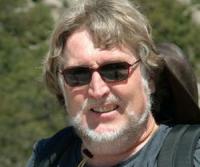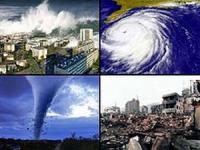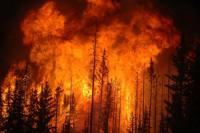-
Why were California’s wine country fires so destructive?

As of late October more than a dozen wildfires north of San Francisco had killed more than 40 people, burned approximately 160,000 acres and destroyed more than 7,000 structures. The path of the destructive 2017 Tubbs fire in Napa and Sonoma counties mirrors that of the Hanley fire of 1964. Strikingly, though, no lives were lost during the Hanley fire and only 29 structures were destroyed. Why did these two fires, 50 years apart, burn on the same general landscape, under similar extreme winds, with such different human impacts? Fire scientists will study these events intensively to parse out the relative importance of various factors. But it is clear that two factors probably were major contributors: wind and population growth. Drought and warmer climates have made wildfires a year-round hazard in California. Expanded urban development, in tandem with hot winds, seems to be the primary reason for the destruction this year.
-
-
Communications system that can withstand natural disasters

In the wake of natural disasters which have brought communication to a standstill, researchers have been leading an international research team to tackle the problems of maintaining communications under hostile conditions. A researcher at Queen’s University Belfast has been shortlisted for the 2017 Newton Prize after he created a robust wireless communications system which can battle through an earthquake, tsunami or hurricane.
-
-
The “Really Big One”: How a 9.0 Cascadia earthquake could play out
One of the worst nightmares for many Pacific Northwest residents is a huge earthquake along the offshore Cascadia Subduction Zone, which would unleash damaging and likely deadly shaking in coastal Washington, Oregon, British Columbia and northern California. The last time this happened was in 1700, before seismic instruments were around to record the event. So what will happen when it ruptures next is largely unknown.
-
-
Simulation technology to predict refugee destinations, improving aid efforts
A computer simulation of refugees’ journeys as they flee major conflicts can correctly predict more than 75 percent of their destinations, and may become a vital tool for governments and NGOs to help better allocate humanitarian resources.
-
-
During crisis, exposure to social media’s conflicting information is linked to stress
Exposure to high rates of conflicting information during an emergency is linked to increased levels of stress, and those who rely on text messages or social media reports from unofficial sources are more frequently exposed to rumors and experience greater distress, according to new research.
-
-
Future NYC flooding will be caused by sea-level rise, not stronger storm surge
Rising sea levels caused by a warming climate threaten greater future storm damage to New York City, but the paths of stronger future storms may shift offshore, changing the coastal risk for the city, according to a team of climate scientists. Future changes in sea level and storms would be smaller if actions were taken to slow climate change, such as the Paris Accord’s goal of limiting warming to 3.6 degrees Fahrenheit.
-
-
Globe had 2nd warmest year to date, 4th warmest September on record
The average global temperature set in September 2017 was 1.40 degrees F above the 20th-century average of 59.0 degrees. This average temperature was the fourth highest for September in the 1880-2017 record. This marked the 41st consecutive September and the 393rd consecutive month with temperatures above the 20th-century average. The year-to-date average temperature was 1.57 degrees F above the 20th-century average of 57.5 degrees. Arctic and Antarctic sea ice coverage remains small.
-
-
Warming seas could lead to 70 percent increase in hurricane-related financial loss
If oceans warm at a rate predicted by the Intergovernmental Panel on Climate Change, the UN-sponsored group that assesses climate change research and issues periodic reports, expected financial losses caused by hurricanes could increase more than 70 percent by 2100, according to researchers. The finding is based on the panel’s most severe potential climate change scenario – and resulting increased sea surface temperature – and is predicted at an 80 percent confidence level. The model drew on hurricane data for the last 150 years gathered by NOAA.
-
-
NOAA-funded effort to better predict droughts
On average, droughts cost an estimated $9 billion in damages every year in the United States, according to NOAA. A single drought in 2012, which spread across the U.S. and brought very dry conditions to Michigan, caused some $32 billion in damage nationwide, mostly due to widespread harvest failure. Scientists work to develop a better system to predict droughts.
-
-
Houston officials let developers build homes inside reservoirs. But no one warned buyers.
Hurricane Harvey forced many Houston-area residents to realize that their homes were built inside the two massive reservoirs which had been built west of Houston decades ago to protect the city from catastrophic flooding. These homeowners are now coming to terms with the fact that in big enough rainstorms, their neighborhoods are actually designed to flood. Trouble is, nobody told them about it. Today, about 14,000 homes are located inside the reservoirs, or “flood pools,” as city planners call them.
-
-
Psychology holds key to getting people out before disaster strikes
Natural disasters are becoming more frequent and intense. Recent hurricanes, floods, bushfires and earthquakes have highlighted the significant potential for mass trauma. Yet we know relatively little about the psychology of decision-making in dangerous conditions. Evacuation is a key strategy for keeping city residents safe. Yet our study identifies several barriers to evacuation in high-density cities. Importantly, psychological factors could affect decision-making in these situations.
-
-
This is only a Test: Asteroid tracking network observes close approach
Yesterday, 12 October 2017, a small asteroid designated 2012 TC4 safely passed by Earth at a distance of approximately 26,000 miles (42,000 kilometers). This is a little over one tenth the distance to the Moon and just above the orbital altitude of communications satellites. This encounter with TC4 was being used by asteroid trackers around the world to test their ability to operate as a coordinated international asteroid warning network.
-
-
Wildfires create much more pollution than previously thought

Naturally burning timber and brush launch what are called fine particles into the air at a rate three times as high as levels officially noted in emissions inventories at the U.S. Environmental Protection Agency, according to a new study. This does not mean that burning biomass produces more pollution than it previously did, but the new research makes clearer how much and what pollutants are inside a wildfire plume. Fine particles, the microscopic, sooty specks that form aerosols, are a hazard to human health, particularly to the lungs and heart.
-
-
After hurricanes, Congress ponders future of flood insurance program
The devastating hit Houston took from Hurricane Harvey has exacerbated — and highlighted — the enormous financial jam facing the National Flood Insurance Program. Thanks to the recent onslaught of hurricanes hitting Texas, Florida and Puerto Rico, there has never been a greater need for the program. But that need has also set off a new round of calls to dramatically overhaul a program that hasn’t been able to sustain itself without major subsidies from the U.S. Treasury.
-
-
Advancing the accuracy of hurricane storm surge forecasts
Of the thirteen named storms so far this season, eight have been hurricanes, with five of the eight — Harvey, Irma, Jose, Lee, and Maria — reaching Category 3 or higher. Storm surge — how high ocean waters rise and where flooding occurs — is often the greatest threat to life and property during a tropical cyclone. A single storm can devastate livelihoods and cause tens of billions of dollars in damage.
-
More headlines
The long view
Trump Aims to Shut Down State Climate Policies
President Donald Trump has launched an all-out legal attack on states’ authority to set climate change policy. Climate-focused state leaders say his administration has no legal basis to unravel their efforts.
